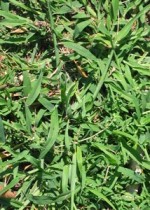 There are many kinds of crabgrass but the two that are the most prevalent in the United States are smooth crabgrass and large crabgrass. They are very similar in appearance and difficult for the gardener to distinguish. This is not a problem since they have similar growth habits, present the same problem in gardens and lawns, and are treated in an identical manner. Smooth crabgrass is shorter than large crabgrass and can withstand mowing better so is a more serious weed in lawns. Both kinds of crabgrass are annuals native to Europe but are common throughout the United States except in the lower South. They prefer full sun and fertile soil but grow well in poor soil and can tolerate hot, dry conditions once established.
There are many kinds of crabgrass but the two that are the most prevalent in the United States are smooth crabgrass and large crabgrass. They are very similar in appearance and difficult for the gardener to distinguish. This is not a problem since they have similar growth habits, present the same problem in gardens and lawns, and are treated in an identical manner. Smooth crabgrass is shorter than large crabgrass and can withstand mowing better so is a more serious weed in lawns. Both kinds of crabgrass are annuals native to Europe but are common throughout the United States except in the lower South. They prefer full sun and fertile soil but grow well in poor soil and can tolerate hot, dry conditions once established.
 Description: Crabgrass is a low growing plant with spreading stems that produce roots at the nodes when they touch the ground. Smooth crabgrass has stems that can grow six inches tall and leaves up to 14 inches long while large crabgrass has stems that grow up to two feet tall and leaves that are closer to 8 inches long. Both kinds of crabgrass produce flowers in 2-8 terminal spikes. Seed production can be huge; up to 150,000 seeds per plant, and seeds can remain viable in the soil for several years. The root system is fibrous.
Description: Crabgrass is a low growing plant with spreading stems that produce roots at the nodes when they touch the ground. Smooth crabgrass has stems that can grow six inches tall and leaves up to 14 inches long while large crabgrass has stems that grow up to two feet tall and leaves that are closer to 8 inches long. Both kinds of crabgrass produce flowers in 2-8 terminal spikes. Seed production can be huge; up to 150,000 seeds per plant, and seeds can remain viable in the soil for several years. The root system is fibrous.
 Control: When crabgrass invades a lawn it is a signal that the lawn is in poor condition and the best way to eliminate the problem is to improve the growing conditions of the desirable grasses. This usually means adjusting the irrigation and fertilizer regime but other good lawn practices can be helpful too. Crabgrass seedlings can’t compete well with a vigorously growing turf so good lawn management practices are vital for a long term solution to the problem.
Control: When crabgrass invades a lawn it is a signal that the lawn is in poor condition and the best way to eliminate the problem is to improve the growing conditions of the desirable grasses. This usually means adjusting the irrigation and fertilizer regime but other good lawn practices can be helpful too. Crabgrass seedlings can’t compete well with a vigorously growing turf so good lawn management practices are vital for a long term solution to the problem.
 Crabgrass in flowerbeds and vegetable gardens presents a different situation. Young plants can easily be hand-pulled or hoed so that their roots are brought to the surface where they will dry up. Light blocking mulch will prevent the germination and growth of new seedlings. Solarization with clear plastic at the time of high solar radiation is also effective. Post- and pre-emergent herbicides are available but are rarely necessary.
Crabgrass in flowerbeds and vegetable gardens presents a different situation. Young plants can easily be hand-pulled or hoed so that their roots are brought to the surface where they will dry up. Light blocking mulch will prevent the germination and growth of new seedlings. Solarization with clear plastic at the time of high solar radiation is also effective. Post- and pre-emergent herbicides are available but are rarely necessary.